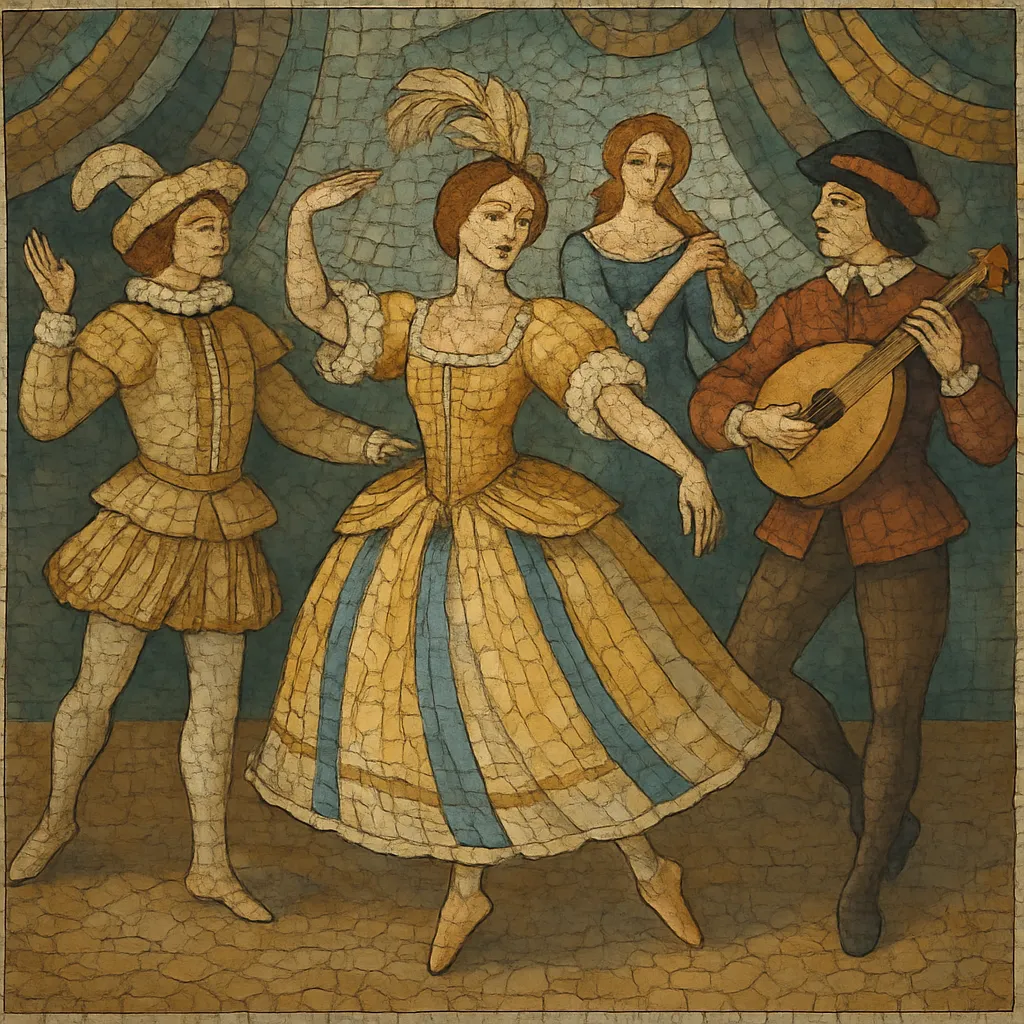Ballet de cour is a French courtly spectacle of the late Renaissance and early Baroque that fused dance, vocal and instrumental music, poetry, elaborate costumes, and stage machinery into lavish, allegorical entertainments. It was performed by a mix of noble amateurs and professional dancers and singers, and it served both as art and as political theater designed to celebrate and legitimize royal power.
Its musical fabric combined airs de cour and choruses with instrumental dances (branles, courantes, sarabandes, gigues, chaconnes, and passacailles). Choreography emphasized geometric floor patterns and ceremonial processions (entrées), culminating in a grand ballet. The genre reached a zenith under Louis XIII and Louis XIV and laid the groundwork for the codified techniques and dramaturgy of later French ballet and opera.
The ballet de cour emerged in France in the late Renaissance, under the patronage of Catherine de’ Medici and the Valois court. A landmark event was the Ballet Comique de la Reine (1581), devised by Balthasar de Beaujoyeulx, which unified poetry, music, dance, and scenic invention into a continuous allegorical narrative. Italian intermedio traditions and court dances shaped its format, while French poetic declamation and song provided its vocal character.
During the reigns of Louis XIII and especially Louis XIV, ballet de cour became central to court culture. Productions consisted of a prologue and a sequence of entrées (self-contained scenes) featuring contrasting characters, costumes, and dance types, all orbiting themes that exalted the monarchy. Louis XIV himself danced prominent roles (notably in Ballet de la Nuit, 1653). Jean-Baptiste Lully, Michel Lambert, Pierre Guédron, and Antoine Boësset contributed music; Pierre Beauchamp advanced choreography and codified the five positions. Institutions such as the Académie Royale de Danse (1661) and the Académie Royale de Musique (1672) professionalized practice and transmission.
By the later 17th century, the genre’s elements were absorbed into new stage forms: Lully and Molière forged the comédie-ballet, and Lully with Quinault established tragédie en musique, both inheriting the ballet de cour’s allegory, dance centrality, and ceremonial grandeur. As opera took precedence, standalone ballets de cour waned, but their techniques—formalized ballet steps, French overture style, and the integration of dance with sung drama—profoundly shaped classical ballet, opera-ballet, and the Baroque dance suite.
Use a flexible court ensemble: voices (soloists and chorus), lutes and theorbos, viols and early violins/violas/violoncellos, recorders and transverse flutes, oboes and bassoons (in later works), plus cornets and sackbuts for ceremonial color. Provide basso continuo (harpsichord, organ, theorbo, or harp) to support voices and strings.
Plan a prologue that flatters the monarch, followed by a series of contrasting entrées (scenes) that alternate vocal numbers (airs de cour and choruses) with instrumental dances. Conclude with a grand ballet where all characters reassemble. Ritournelles and fanfares can articulate scene changes; in late-17th-century style, begin major sections with a French overture (dotted rhythms, majestic tempo) leading into quicker imitative writing.
Compose characteristic dance types with clear, regular phrasing and stable meters: branle (duple, processional), courante (triple, flowing), sarabande (slow triple with emphasis on beat 2), gigue (lively compound meter), chaconne and passacaille (triple meter, repeating-bass variations). Keep textures transparent and rhythms square enough for choreography, allowing notes inégales and tasteful ornaments to supply French lilt.
Favor singable, syllabic melodies in French for airs de cour, often strophic with modest ambitus. Harmony should be clear and triadic, with modal color gradually giving way to emerging tonal cadences. Use sequences and ground-bass patterns for variation dances (chaconne/passacaille), and cadences that align with choreographic phrases.
Build scenes around mythological and pastoral allegories that praise royal virtues (order, magnanimity, victory). Assign distinct tonal areas, timbres, and step-vocabularies to different character groups (nations, elements, seasons). Integrate chorus for communal statements and employ instrumental interludes for costume changes and machinery cues.
Write music in danceable tempi with consistent phrase lengths (multiples of 4 or 8 bars). Coordinate with the choreographer to map geometric floor patterns and entries. Allow space for processions and tableaux, and conclude with a unifying grand ballet that gathers the court and principal characters.


